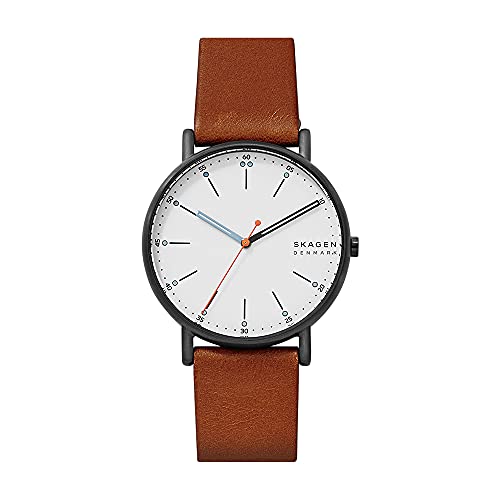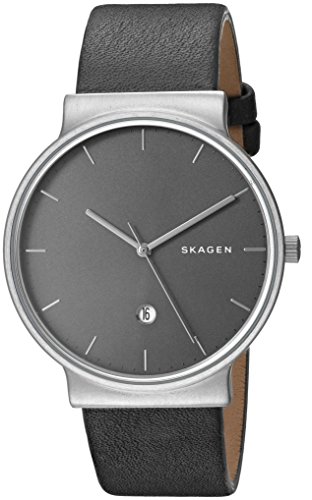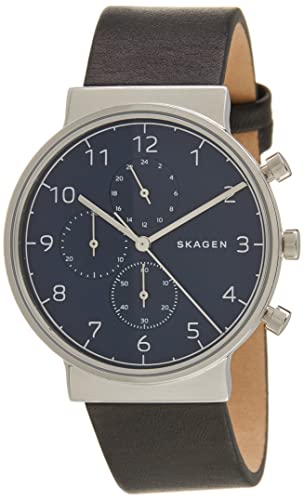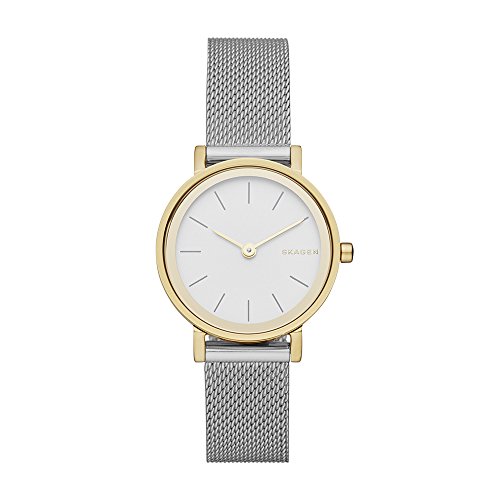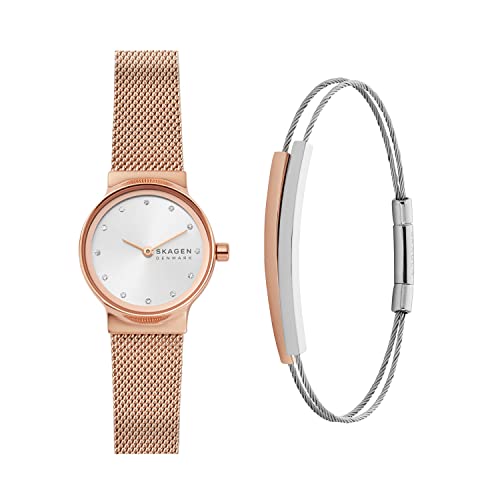If you’re a fan of sleek and minimalist designs, chances are you’ve come across Skagen watches. With their undeniable aesthetic appeal, it’s no wonder these timepieces have captured the hearts of many. But here’s the thing – beauty isn’t the only thing that matters when it comes to watches. Functionality and durability are equally important factors to consider. And when it comes to that all-important question of waterproofness, are Skagen watches up to the task? Let’s dive in and find out.
Top Picks for Sleek and Stylish Skagen Watches
Understanding Water Resistance
Water resistance is a critical feature to consider when purchasing a watch, especially if you lead an active lifestyle or enjoy water-related activities. In this blog section, we will take a closer look at what water resistance means and how it is measured, so you can make an informed decision when choosing a watch that suits your needs.
What is Water Resistance?
When we talk about water resistance in watches, we refer to the watch’s ability to withstand moisture or water without getting damaged. It is essential to note that water resistance does not mean the watch is completely waterproof. It is about how well the watch can resist the entry of water under specific conditions.
How is Water Resistance Measured?
Water resistance is typically measured in meters and indicates the depth to which a watch can be submerged without allowing water to penetrate its internal mechanisms. The measurement is based on laboratory tests and simulates real-world scenarios, such as swimming, snorkeling, or scuba diving.
Here are some common water resistance ratings and what they signify:
- 30m (3 ATM): Suitable for everyday use and can withstand splashes or rain. Not suitable for swimming or diving.
- 50m (5 ATM): Suitable for swimming, snorkeling, and other shallow-water activities. Not suitable for high-impact water sports or scuba diving.
- 100m (10 ATM): Suitable for recreational swimming, snorkeling, and water sports. Not suitable for scuba diving.
- 200m (20 ATM) or more: Ideal for professional divers or extreme water activities. Can withstand high-pressure environments and deep-sea dives.
It is important to note that water resistance ratings are static, meaning they are valid when the watch is stationary. Rapid movements, such as diving into the water or operating the chronograph function while submerged, can potentially exceed the specified water resistance levels and lead to water entering the watch.
Factors Affecting Water Resistance
Several factors can influence the water resistance of a watch, including:
- Seals and Gaskets: Watches have rubber or silicone seals around their joints, crowns, and pushers. These seals prevent water from entering the watch. Over time, these seals can deteriorate, compromising the watch’s water resistance. Regular maintenance and replacing worn-out seals are crucial to maintaining the watch’s water-resistant properties.
- Screw-Down Crowns: Some watches feature screw-down crowns, which create an airtight seal when fully tightened. This added protection ensures water resistance. Remember to always screw the crown back in tightly after adjusting the time or date to maintain the water resistance level.
- Crystal Material: The watch crystal, typically made of mineral glass, sapphire, or acrylic, plays a role in water resistance. Sapphire crystals are highly resistant to scratches and offer superior water resistance compared to mineral glass or acrylic crystals.
Benefits of Water Resistance
Investing in a water-resistant watch brings several benefits:
- Versatility: A water-resistant watch allows you to wear it confidently in various settings, including outdoor activities and everyday use, without worrying about water damage.
- Durability: Water-resistant watches are often built to withstand more than just water exposure. They are designed to be robust and endure tough conditions, ensuring longevity and durability.
- Peace of Mind: Whether you’re swimming, snorkeling, or caught in the rain, a water-resistant watch lets you focus on enjoying the moment instead of worrying about the watch getting damaged by water.
In conclusion, understanding water resistance is vital when choosing a watch that can withstand your specific activities and environments. Knowing the water resistance rating, maintaining the watch’s seals and gaskets, and opting for reliable materials will help ensure the longevity and functionality of your water-resistant timepiece.
Skagen’s Water Resistance Ratings
Water resistance is an important factor to consider when purchasing a watch, especially if you lead an active lifestyle or plan to wear it in water-related activities. Skagen understands the significance of this feature and offers a range of water-resistant watches with different ratings. In this blog section, we will delve into the details of Skagen’s water resistance ratings to help you make an informed decision.
What are Water Resistance Ratings?
Water resistance ratings indicate the level of water pressure a watch can withstand without allowing water to penetrate its inner workings. These ratings are typically measured in atmospheres (ATM) or meters (M). Skagen watches primarily use the ATM measurement, which is equivalent to the pressure exerted by a column of water at a specific depth.
3 ATM (30 meters)
Skagen’s watches with a water resistance rating of 3 ATM (30 meters) are suitable for everyday use and can withstand splashes or brief immersion in water. While they are not designed for swimming or diving, these watches can handle accidental water exposure, such as wearing them in the rain or washing your hands.
Key points about 3 ATM water resistance rating:
- Can withstand splashes
- Suitable for everyday use
- Not suitable for swimming or diving
- Accidental water exposure is safe
5 ATM (50 meters)
If you’re looking for a watch that can handle more water-related activities, Skagen offers watches with a water resistance rating of 5 ATM (50 meters). These watches are suitable for swimming and showering. While they can handle these activities, we recommend avoiding extreme water pressure, as they are not intended for scuba diving or other deep-water activities.
Key points about 5 ATM water resistance rating:
- Suitable for swimming and showering
- Not suitable for scuba diving or deep-water activities
- Handles everyday water exposure comfortably
- Extended water exposure should be avoided
10 ATM (100 meters)
For those seeking watches that can accompany them on underwater adventures, Skagen’s 10 ATM (100 meters) water resistance rating is worth considering. These watches are suitable for snorkeling and recreational diving. With their enhanced water-resistant construction, they can withstand the increased pressure encountered during these activities.
Key points about 10 ATM water resistance rating:
- Suitable for snorkeling and recreational diving
- Can withstand increased water pressure
- Handles everyday water exposure and accidental immersion confidently
- Not intended for professional diving or saturation diving
Comparison Table
To summarize the key information about Skagen’s water resistance ratings, here’s a comparison table:
| Water Resistance Rating | Suitable For |
|---|---|
| 3 ATM (30 meters) | Everyday use, splashes, brief immersion |
| 5 ATM (50 meters) | Swimming, showering |
| 10 ATM (100 meters) | Snorkeling, recreational diving |
Remember that these water resistance ratings apply to the watch case and are not indicative of the water resistance of other components, such as leather or fabric straps. It’s crucial to take care of your watch and avoid unnecessary exposure to water when not explicitly specified as safe by the water resistance rating.
In conclusion, Skagen offers a diverse collection of water-resistant watches with different water resistance ratings to cater to varying needs and preferences. Whether you’re seeking a watch for everyday use, swimming, or even recreational diving, Skagen has you covered.
Factors to Consider
Skagen watches are known for their sleek design and quality craftsmanship. Along with their stylish appearance, many Skagen watches also offer varying degrees of water resistance, making them suitable for everyday wear and even water-based activities. However, before you take your Skagen watch for a swim or expose it to water, there are several factors to consider to ensure its longevity and performance. In this blog section, we will explore these factors, including age, condition, regular maintenance, extreme temperature changes, chemicals, and water pressure.
Age of the Watch
The age of your Skagen watch plays a crucial role in its water resistance capabilities. Over time, the materials used in the watch, such as gaskets and seals, can deteriorate, compromising the watch’s ability to resist water. Therefore, it is important to be mindful of the age of your watch and evaluate its water resistance accordingly.
Condition of the Watch
In addition to age, the overall condition of your Skagen watch is another factor to consider when exposing it to water. Regular wear and tear, accidental impacts, or exposure to harsh chemicals can weaken the watch’s structure and compromise its water resistance. It is recommended to inspect your watch for any signs of damage, such as cracks, loose components, or worn-out seals, before subjecting it to water.
Regular Maintenance
Proper maintenance is essential for ensuring the longevity and water resistance of your Skagen watch. Regular service and maintenance appointments with a certified watch technician will help identify and address potential issues before they become a problem. Such maintenance may include cleaning, lubrication, and replacement of worn-out gaskets or seals.
Extreme Temperature Changes
Extreme temperature changes can affect the water resistance of your Skagen watch. Sudden exposure to high heat, such as a sauna or hot tub, can cause the seals to expand and potentially lead to water infiltration. Similarly, exposing your watch to extreme cold temperatures can cause the seals to contract and compromise the watch’s water resistance. It is important to avoid exposing your watch to such temperature extremes to maintain its water resistance capabilities.
Chemicals and Water Pressure
Chemicals present in everyday products such as perfumes, lotions, and cleaning agents can degrade the gaskets and seals of your Skagen watch. Therefore, it is advisable to remove your watch before applying any such substances, as they can compromise the watch’s water resistance.
Additionally, water pressure plays a crucial role in determining the water resistance of your Skagen watch. Various water-related activities, such as diving or snorkeling, can subject your watch to higher pressure levels than it is designed to withstand. It is important to consult the water resistance rating of your specific Skagen watch and avoid exceeding its recommended water pressure limits to prevent any damage.
Key Points to Remember:
- Consider the age and condition of your Skagen watch before exposing it to water.
- Regular maintenance appointments with a certified watch technician are vital for ensuring water resistance.
- Avoid exposing your watch to extreme temperature changes to prevent compromising its water resistance.
- Remove your watch before applying chemicals to maintain its water resistance.
- Do not exceed the recommended water pressure limits specified for your Skagen watch.
By considering these factors and adhering to the recommended guidelines, you can enjoy the water resistance capabilities of your Skagen watch for years to come while ensuring its optimal performance. Remember, taking preventive measures is key to keeping your timepiece in pristine condition and protecting your investment.
Recommendation for Water Resistance in Skagen Watches
When it comes to Skagen watches, it is important to understand their water resistance ratings and factors to consider before exposing them to water. This knowledge will ensure that you make the right decisions to extend the longevity of your watch and avoid any water damage.
Understanding Water Resistance Ratings
Water resistance ratings are crucial in determining the level of protection your Skagen watch has against water ingress. Skagen watches typically have water resistance ratings ranging from 3 ATM (atmospheres) to 10 ATM. However, it is essential to note that these ratings do not mean the watch is suitable for all water activities.
- 3 ATM (30 meters) – Suitable for everyday use and can withstand accidental splashes or brief immersion in water.
- 5 ATM (50 meters) – A higher level of water resistance, suitable for swimming, showering, and snorkeling but not recommended for scuba diving.
- 10 ATM (100 meters) – The highest level of water resistance offered by most Skagen watches. Suitable for most water activities, including swimming, snorkeling, and diving, but not for deep-sea diving or saturation diving.
Factors to Consider
While the water resistance rating is an essential consideration, other factors also determine a watch’s ability to withstand water exposure. These factors include the quality of seals, crown and button functionality, and overall construction.
Key points to consider when evaluating water resistance:
- Quality of seals – Ensure that the watch has high-quality gaskets and seals to prevent water from penetrating the case.
- Crown and button functionality – The crown and buttons should be tightly sealed when not in use to maintain water resistance.
- Construction – The watch should have robust construction and materials, such as stainless steel, to withstand water pressure.
Recommended Precautions
To ensure the longevity and maintain the water resistance of your Skagen watch, here are some precautionary measures to follow:
- Avoid unnecessary exposure to water: Even if your Skagen watch has a high water resistance rating, it is recommended to avoid unnecessary exposure to water. This includes avoiding swimming or showering while wearing the watch, especially if it has a water resistance rating below 5 ATM.
- Regularly check the watch’s condition: Periodically inspect your Skagen watch for any signs of damage, such as cracked or damaged seals. Regular maintenance and inspection will help identify issues early and prevent water damage.
- Have the watch serviced by a professional: If you notice any water entry or suspect a compromise in the watch’s water resistance, it is best to have it serviced by a professional watchmaker. They can ensure the seals are intact and replace any damaged components.
Final Verdict: Skagen watches and their waterproof capabilities
To summarize, while Skagen watches aren’t completely waterproof, they do provide some level of water resistance. It’s crucial to know the specific water resistance rating of each model and take precautions accordingly. By doing so, users can enjoy their watches without compromising their durability and performance.

